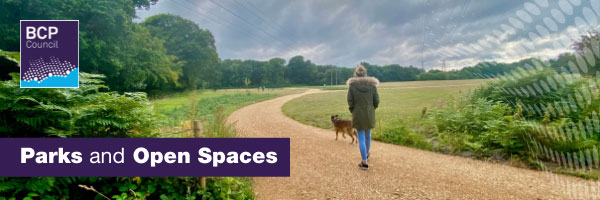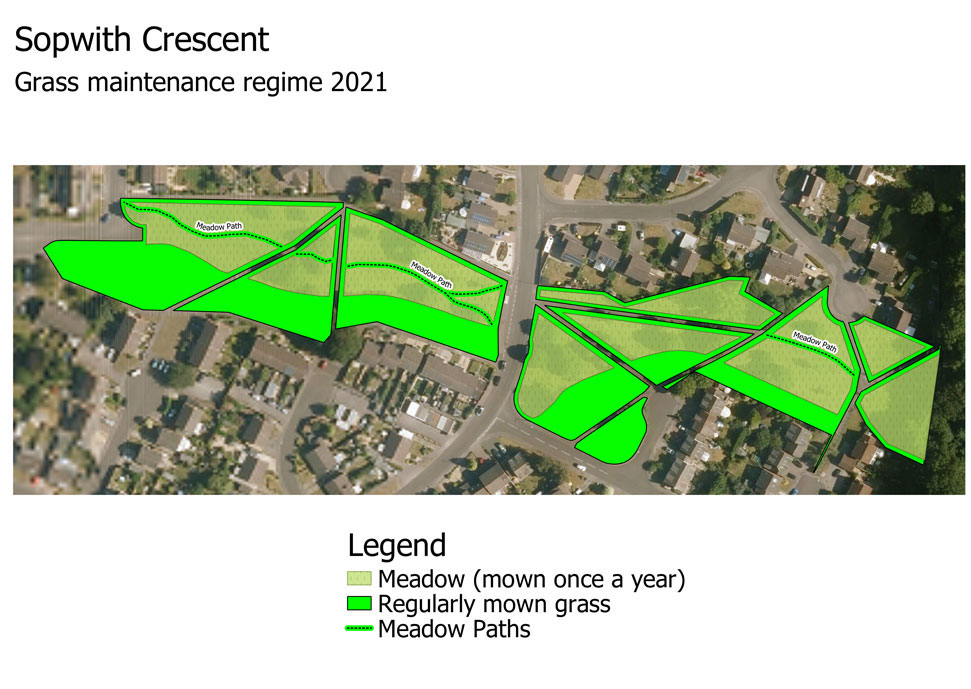Sopwith Crescent open space, Merley
Grass & meadow management regime
Updated 10th March 2021
Sopwith Crescent open space
Consultation October-November 2020
The consultation period has now ended
In late 2020, BCP Council carried out a consultation with local residents to hear their views on proposed changes to the grass cutting schedules at Sopwith Crescent to allow the formation of meadow areas.
Thank you very much to everyone who took the time to complete our survey. We’re pleased to share with you a map showing the agreed mowing regime, together with a summary of the consultation feedback we received for more information.
The new maintenance regime
Click on a map to enlarge it in your browser window, or use the blue button below it to download a pdf copy, thank you
Your feedback

“There is a clear division of views on the proposals for meadow growth at Sopwith Crescent, with arguments for and against. Health and safety is of concern to many local residents, with a worry around the impact of ticks on pets, fire risk to local properties and pollen and its impacts on people’s allergies and general health. This formed the basis of most ‘against’ arguments, whilst many ‘for’ arguments were based around the environmental benefits that are needed within the area and wider global context.”
Read more (pdf, 2Mb)
Why we undertook this project, and the benefits it should bring
The background locally
Sopwith Crescent open space is a series of small connected green spaces in Merley. Running alongside Sopwith Crescent it is mainly amenity grassland with some tree cover.
During lockdown, a lack of grounds maintenance staffing capacity across BCP Council meant that areas of previously mown grassland were left to grow longer. Sopwith Crescent was one of these areas, where grassy meadows developed.
BCP council wanted to find out what local residents and other users thought about leaving these patches of longer grass as shown on the maps below. We wanted to understand what support there would be for changing the mowing schedules to allow meadows to establish and develop.
What is a grassy meadow?
A grassy meadow is grassland which is left uncut for much of the year. The grass, and flowers within it, are allowed to grow tall and mature and so provide shelter and ‘nurseries’ and a source of nectar and seed for all kinds of wildlife. Many people find grassy meadows attractive as they create seasonal interest and a sense of proximity to nature as the vegetation changes throughout year.
Grassy meadows differ from ornamental annual wildflower meadows which are commonly seen in more formal settings. These provide very colourful displays but take a great deal of resources to establish and renew every year. They often contain non-native species. Although they do provide a source of nectar, they do not have the wildlife benefits associated with uncut grassland.
Benefits to wildlife
A wide range of invertebrates such as moths, butterflies, bees, beetles, grasshoppers and spiders all benefit from the shelter and food offered by long grass meadows, and as a direct result of this the numbers of birds, bats and hedgehogs and other small mammals can all be boosted locally due to the increased food provided by the insect population and the grass seeds.
Populations of grassland butterflies have declined almost 50% over two decades and species such as the Meadow Brown, Ringlet, Small Heath and the Skippers amongst others need long, undisturbed grasses in which to lay their eggs where they will then hatch, feed and hibernate as caterpillars. In the spring, the caterpillars resume feeding on fresh growth and when fully grown, will transform into a chrysalis for 3-4 weeks, emerging anytime from June – September as a butterfly that lives a short life for just a few days.
Moths such as the Large Yellow Underwing feed on grasses and make up a large part of the diet of many other species, either in their larval stage or as a flying adult.
Meadow & Field Grasshopper amongst others feed on long grasses through the summer and provide great entertainment for children trying to spot them. Common Carder Bees build their nests in grassy tussocks.
Ground feeding birds in particular enjoy grass seeds as they are tasty and easy to swallow. Because finches and sparrows have soft beaks, they can easily pick up the small seeds and gain great nourishment from it. Birds tend to prefer seeds with a thinner shell but will eat any variety if they’re hungry enough.
Long grassy areas can add an invaluable area to many wildlife species and can be very low maintenance, only requiring a mow once a year, but for many caterpillars and other tiny wildlife species, you are doing them a favour if it’s left all winter too.
The issues across BCP Council
- The management of grass areas is an important grounds maintenance function with a significant amount of time and resource allocated towards it.
- There are different management methods used throughout Bournemouth, Christchurch and Poole. This is largely determined by the designation and use of the land. The adopted management practice for a given area will influence a number of factors, as follows:
a. Time required to carry out operations
b. Resources needed, including the requirement for dedicated teams and machinery
c. When to undertake operations i.e. time of year and frequency - Management of grass areas will also have an impact on wildlife and the environment and this varies depending on the method used.
- Increased environmental awareness, ongoing financial pressures and the Council’s declaration of a Climate and Ecological Emergency (and pledge to become carbon neutral by 2030) has resulted in a need to review the management of grass areas throughout BCP and implement sustainable, ecologically sound practices.
- Grass management practices must contribute to the required reduction in carbon emissions whilst remaining within current and future budget constraints, and also meet approved levels of public satisfaction.
- Implementation of agreed management methods will also contribute towards consistency of operations throughout the combined Bournemouth, Christchurch and Poole Council area.
- Regular cutting of amenity grass areas, irrespective of location and the amount of use they receive is a traditional practice largely undertaken to maintain an accepted appearance.
- In parks and open spaces this has resulted in many hectares of ‘green desert’; expanses of closely mown grass that are rarely used for the types of recreational activities where short grass is essential. They can also lack diversity with regards to visual appearance and the species that they support.
- In recent years, an increased awareness of environmental issues has already resulted in a change to some traditional practices. One of these is to identify areas, generally within amenity grass and highway verge, and manage them as grass meadows.
The establishment of grassy meadows can have a number of potential benefits, and not just for wildlife
- Increase in biodiversity. By creating conditions that support a range of plants and wildlife, in particular pollinators which have suffered widespread decline.
- Reduction in atmospheric pollution. By trapping potentially harmful airborne particulates.
- Carbon sequestration. By removing CO2 from the atmosphere and storing it in the soil.
- Redeployment of resources to priority areas. For example, to areas that do require more frequent cutting such as sports pitches.
- Reduction of CO2 emissions. If there is an overall reduction in machinery usage.
- Reduction in operational costs. If an overall reduction in the use of resources is achieved.
- Reduction in soil nutrients. Produces less vigorous growth resulting in a reduction of arising requiring disposal. Aids in the establishment of a variety of species rather than supporting predominantly vigorous grasses.
For information on creating and maintaining a mini-meadow in your garden, visit The Wildflower Garden website
Join us on Facebook
The Parks Foundation
Parks & Open Spaces Newsletter; please click here to subscribe to a regular copy






